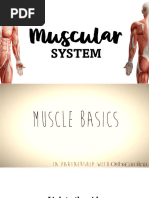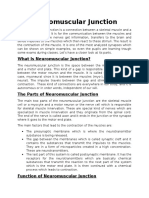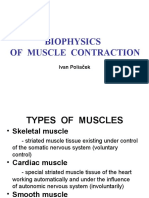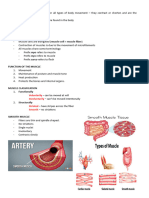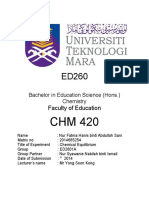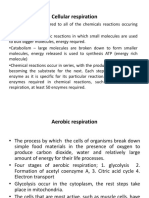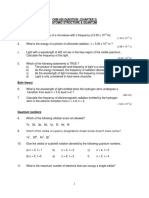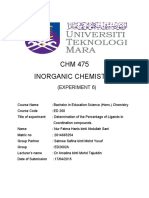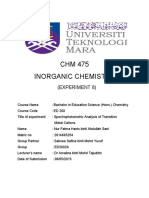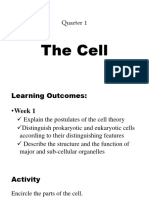0 ratings0% found this document useful (0 votes)
28 viewsThe Muscular System
The muscular system consists of skeletal, smooth and cardiac muscles that allow movement, maintain posture, and circulate blood. The nervous system controls muscle contraction through neuromuscular junctions where motor neurons release acetylcholine, which triggers a chemical reaction in the muscle cell and the release of calcium, causing muscle fibers to contract. Repeated muscle fiber contraction leads to full muscle contraction and movement.
Uploaded by
FAtma HAnysCopyright
© © All Rights Reserved
Available Formats
Download as PPTX, PDF, TXT or read online on Scribd
0 ratings0% found this document useful (0 votes)
28 viewsThe Muscular System
The muscular system consists of skeletal, smooth and cardiac muscles that allow movement, maintain posture, and circulate blood. The nervous system controls muscle contraction through neuromuscular junctions where motor neurons release acetylcholine, which triggers a chemical reaction in the muscle cell and the release of calcium, causing muscle fibers to contract. Repeated muscle fiber contraction leads to full muscle contraction and movement.
Uploaded by
FAtma HAnysCopyright
© © All Rights Reserved
Available Formats
Download as PPTX, PDF, TXT or read online on Scribd
You are on page 1/ 22
The Muscular system
The Muscular system
The muscular system is an organ system consisting
of skeletal, smooth and cardiac muscles.
It permits movement of the body, maintains posture, and
circulates blood throughout the body.
The muscular system in vertebrates is controlled through
the nervous system, although some muscles (such as
the cardiac muscle) can be completely autonomous.
Together with the skeletal system it forms
the musculoskeletal system, which is responsible for
movement of the human body.
Nervous System Controls Muscle Contraction
• Neuromuscular juntions are the focal point where a motor
neuron attaches to a muscle.
• Acetylcholine, (a neurotransmitter used in skeletal muscle
contraction) is released from the axon terminal of the
nerve cell when an action potential reaches the
microscopic junction, called a synapse.
• A group of chemical messengers cross the synapse and
stimulate the formation of electrical changes, which are
produced in the muscle cell when the acetylcholine binds
to receptors on its surface.
Neuromuscular
Nervous System Controls Muscle Contraction
• Calcium is released from its storage area in the cell's
sarcoplasmic reticulum.
• An impulse from a nerve cell causes calcium release
and brings about a single, short muscle
contraction called a muscle twitch.
• If there is a problem at the neuromuscular junction, a
very prolonged contraction may occur, tetanus. Also,
a loss of function at the junction can
produce paralysis.
Transmission of Nerve Impulse
Muscle Contraction Mechanism
Muscle Contraction Mechanism
• A motor neuron releases acetylcholine into the gap
between neuron and muscle fibre.
• The acetylcholine combines with reseptors on the
surface of the muscle fibre.
• This results in depolarization (an electrical change) of
the plasma membrane and initiation of an action
potential, an electric current that spreads over the
plasma membrane.
• The action potential spreads through the T tubules
and stimulates calcium release into the cytoplasm.
Muscle Contraction Mechanism
• Calcium initiates a process that uncovers the binding
sites of the actin filaments.
• Myosin splits ATP. Myosin heads attach to the binding
sites of the actin filaments.
• As the cross bridges flex and reattach to new binding
sites, the filaments are pulled past one another and
the muscle shorten. A new ATP must bind to the
myosin head before the cross bridge can detach itself
from the actin and begin a new cycle. The process is
repeated .
You might also like
- CHM 420 Question (Chapter 4) (Periodic Table) : HAAH/2013No ratings yetCHM 420 Question (Chapter 4) (Periodic Table) : HAAH/20132 pages
- Chapter 9: Muscle and Muscle Tissue Chapter 10: Muscular SystemNo ratings yetChapter 9: Muscle and Muscle Tissue Chapter 10: Muscular System5 pages
- L-3 - Locomotion and Movement - Sept 30, 2019 PDF100% (1)L-3 - Locomotion and Movement - Sept 30, 2019 PDF45 pages
- Neuromuscular Junction: Dr. Mustafa Al-Shehabat MSC, PH.D100% (1)Neuromuscular Junction: Dr. Mustafa Al-Shehabat MSC, PH.D32 pages
- The Muscular System: B. Pimentel, M.D. University of Makati - College of NursingNo ratings yetThe Muscular System: B. Pimentel, M.D. University of Makati - College of Nursing71 pages
- CH 11 - Physiology - Movement and Nervous System - SNo ratings yetCH 11 - Physiology - Movement and Nervous System - S47 pages
- Sistema Muscular Md Afs Fade.up.16.11.2021No ratings yetSistema Muscular Md Afs Fade.up.16.11.202119 pages
- Muscle Physiology: Biology 25 Lecture Anna Theresa A. Santiago, MPHNo ratings yetMuscle Physiology: Biology 25 Lecture Anna Theresa A. Santiago, MPH26 pages
- Investigation of Mechanisms of Skeletal Muscle ContractionNo ratings yetInvestigation of Mechanisms of Skeletal Muscle Contraction14 pages
- The Muscular System How Muscles Enable Movement and Support The BodyNo ratings yetThe Muscular System How Muscles Enable Movement and Support The Body3 pages
- The Muscular System The Muscular System: © 2018 Pearson Education, Ltd. 1No ratings yetThe Muscular System The Muscular System: © 2018 Pearson Education, Ltd. 114 pages
- Muscles and Muscle Tissue: Functional Anatomy, Excitation-Contraction CouplingNo ratings yetMuscles and Muscle Tissue: Functional Anatomy, Excitation-Contraction Coupling46 pages
- Experiment 4 Stoichiometry and Theoretical YieldNo ratings yetExperiment 4 Stoichiometry and Theoretical Yield8 pages
- CHM 420 Question (Chapter 3) Atomic Structure & Quantum Electromagnetic WavesNo ratings yetCHM 420 Question (Chapter 3) Atomic Structure & Quantum Electromagnetic Waves2 pages
- Exp 3,4&5 Nur Fatma Hanis Binti Abdullah SaniNo ratings yetExp 3,4&5 Nur Fatma Hanis Binti Abdullah Sani21 pages
- CHM 420 Questions (Chapter 1) Measurement Matter: HAAH/2013No ratings yetCHM 420 Questions (Chapter 1) Measurement Matter: HAAH/20132 pages
- CHM 475 Inorganic Chemistry: (Experiment 5)No ratings yetCHM 475 Inorganic Chemistry: (Experiment 5)7 pages
- CHM 420 Questions (Chapter 2) Stoichiometry Naming: HAAH/2013No ratings yetCHM 420 Questions (Chapter 2) Stoichiometry Naming: HAAH/20132 pages
- EXP 7 Nur Fatma Hanis Binti Abdullah SaniNo ratings yetEXP 7 Nur Fatma Hanis Binti Abdullah Sani6 pages
- CHM 475 Inorganic Chemistry: (Experiment 6)No ratings yetCHM 475 Inorganic Chemistry: (Experiment 6)11 pages
- CHM 475 Inorganic Chemistry: (Experiment 8)No ratings yetCHM 475 Inorganic Chemistry: (Experiment 8)5 pages
- Bio511: Assignment 1: Aabbcc X Aabbcc. Assume That You Are Working With A Species That Produces LargeNo ratings yetBio511: Assignment 1: Aabbcc X Aabbcc. Assume That You Are Working With A Species That Produces Large2 pages
- CHM 475 Inorganic Chemistry: (Experiment 2)No ratings yetCHM 475 Inorganic Chemistry: (Experiment 2)11 pages
- Exp 1 & 2 Nur Fatma Hanis Binti Abdullah SaniNo ratings yetExp 1 & 2 Nur Fatma Hanis Binti Abdullah Sani20 pages
- Function of Cytoplasmic Granules in CellNo ratings yetFunction of Cytoplasmic Granules in Cell13 pages
- NAME: Christan Y. Tabia SECTION: B1-G12-05-STEM STM 007: General Biology 1 2 Performance TaskNo ratings yetNAME: Christan Y. Tabia SECTION: B1-G12-05-STEM STM 007: General Biology 1 2 Performance Task12 pages
- Transportation & Translocation in PlantsNo ratings yetTransportation & Translocation in Plants25 pages
- Bio CH 2 (Cell - The Unit of Life) Book Exercise Answers100% (1)Bio CH 2 (Cell - The Unit of Life) Book Exercise Answers15 pages
- Chapter 5 Tissues and Primary Growth of StemsNo ratings yetChapter 5 Tissues and Primary Growth of Stems47 pages
- Transportation - Life Processes Class 10 Notes: Transportation in Human Beings: The Circulatory System Is Responsible For50% (2)Transportation - Life Processes Class 10 Notes: Transportation in Human Beings: The Circulatory System Is Responsible For4 pages
- [Ebooks PDF] download The Histology of Fishes 1st Edition Krzysztof Formicki (Editor) full chapters100% (3)[Ebooks PDF] download The Histology of Fishes 1st Edition Krzysztof Formicki (Editor) full chapters55 pages
- DR. WZCA SEC 1 SCIENCE Revision Notes For Chapter 6No ratings yetDR. WZCA SEC 1 SCIENCE Revision Notes For Chapter 614 pages
- CHM 420 Question (Chapter 4) (Periodic Table) : HAAH/2013CHM 420 Question (Chapter 4) (Periodic Table) : HAAH/2013
- Chapter 9: Muscle and Muscle Tissue Chapter 10: Muscular SystemChapter 9: Muscle and Muscle Tissue Chapter 10: Muscular System
- Neuromuscular Junction: Dr. Mustafa Al-Shehabat MSC, PH.DNeuromuscular Junction: Dr. Mustafa Al-Shehabat MSC, PH.D
- The Muscular System: B. Pimentel, M.D. University of Makati - College of NursingThe Muscular System: B. Pimentel, M.D. University of Makati - College of Nursing
- CH 11 - Physiology - Movement and Nervous System - SCH 11 - Physiology - Movement and Nervous System - S
- Muscle Physiology: Biology 25 Lecture Anna Theresa A. Santiago, MPHMuscle Physiology: Biology 25 Lecture Anna Theresa A. Santiago, MPH
- Investigation of Mechanisms of Skeletal Muscle ContractionInvestigation of Mechanisms of Skeletal Muscle Contraction
- The Muscular System How Muscles Enable Movement and Support The BodyThe Muscular System How Muscles Enable Movement and Support The Body
- The Muscular System The Muscular System: © 2018 Pearson Education, Ltd. 1The Muscular System The Muscular System: © 2018 Pearson Education, Ltd. 1
- Muscles and Muscle Tissue: Functional Anatomy, Excitation-Contraction CouplingMuscles and Muscle Tissue: Functional Anatomy, Excitation-Contraction Coupling
- CHM 420 Question (Chapter 3) Atomic Structure & Quantum Electromagnetic WavesCHM 420 Question (Chapter 3) Atomic Structure & Quantum Electromagnetic Waves
- CHM 420 Questions (Chapter 1) Measurement Matter: HAAH/2013CHM 420 Questions (Chapter 1) Measurement Matter: HAAH/2013
- CHM 420 Questions (Chapter 2) Stoichiometry Naming: HAAH/2013CHM 420 Questions (Chapter 2) Stoichiometry Naming: HAAH/2013
- Bio511: Assignment 1: Aabbcc X Aabbcc. Assume That You Are Working With A Species That Produces LargeBio511: Assignment 1: Aabbcc X Aabbcc. Assume That You Are Working With A Species That Produces Large
- NAME: Christan Y. Tabia SECTION: B1-G12-05-STEM STM 007: General Biology 1 2 Performance TaskNAME: Christan Y. Tabia SECTION: B1-G12-05-STEM STM 007: General Biology 1 2 Performance Task
- Bio CH 2 (Cell - The Unit of Life) Book Exercise AnswersBio CH 2 (Cell - The Unit of Life) Book Exercise Answers
- Transportation - Life Processes Class 10 Notes: Transportation in Human Beings: The Circulatory System Is Responsible ForTransportation - Life Processes Class 10 Notes: Transportation in Human Beings: The Circulatory System Is Responsible For
- [Ebooks PDF] download The Histology of Fishes 1st Edition Krzysztof Formicki (Editor) full chapters[Ebooks PDF] download The Histology of Fishes 1st Edition Krzysztof Formicki (Editor) full chapters
- DR. WZCA SEC 1 SCIENCE Revision Notes For Chapter 6DR. WZCA SEC 1 SCIENCE Revision Notes For Chapter 6





